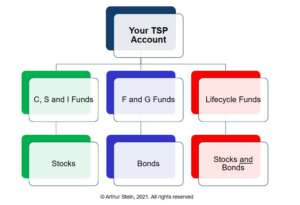Most of us with money in a 401k, IRA or some other form of retirement account think of ourselves as investors. In the quiet of our homes or apartments we may, at times, feel like time players. Kings of Wall Street. That sort of thing!
But is it possible that instead of being major players, some with 7-figure nest eggs, that we are actually more like relatively affluent parking lot attendants? Parkers, not investors?
Financial planner Arthur Stein believes that millions of active and retired feds — anyone with money in the treasury securities G-fund, or F (bond) fund — are not investors in the true sense. They are, in a sense, putting (or parking) their money in funds that don’t move like the stock market.
People in the C fund, S fund and I fund, however, are investing in stocks (large, small cap and an international stock index). And while the C fund, S fund and I funds do go up and down — sometimes big time — over the long haul they have outperformed the treasury and bond funds. By a lot.
Not that there’s anything wrong with that!
Or is there?
So what’s the difference between a true investor and a parker? We’re gonna find out today. Art Stein will be my guest on our Your Turn show at 10 a.m. EDT. You can listen anywhere in the world, or on 1500 AM in the Washington-Baltimore area. Or catch it later when it is archived on our home page. Bottom line is listen to see if you are an investor, parker or maybe both. And the pros and cons (both in investment returns and peace of mind, of being one or the other). Or a combination of both.
If you have questions for him please send them to me before showtime at: mcausey@federalnewsnetwork.com.
Meantime, here’s his explanation of what an investment is, and isn’t:
The TSP Is Not an Investment!
The TSP is not an investment. The 15 funds available to TSP participants are not investments. The TSP funds are a way to own investments.
The only “investments” available in the TSP are stocks and bonds. Stocks and bonds are investments because they increase or decrease in value, produce income or do both. Choosing TSP funds means choosing to invest in stocks or bonds or both.

TSP participants also determine their allocation between different types of stocks and bonds by choosing among the 15 available funds.

“Asset allocation” is the percentage you invest in different types of stocks and bonds by choosing among the different TSP funds. Your asset allocation between stocks and bonds is important for many reasons, including:
- The U.S. stock funds (C and S) outperformed the bond funds over the last 1, 5, 10 and 15 years. The U.S. stock fund outperformance was substantial.
- All three stock funds are much more volatile (fluctuate in value by greater amounts) than the bond funds. And the G-fund never fluctuates in value (zero volatility).
- All the funds (except G) involve the risk of loss of principal and earnings. The G-fund is guaranteed by the U.S. Government, which means losses should never occur.
- Past performance is no guarantee of future performance.
Asset allocation should be based upon your financial and personal situation. For instance:
- How high a return you will need to maintain an investment balance when making withdrawals during retirement.
- Risk tolerance – Emotional ability to ignore market fluctuations and losses in order to obtain long-term gains.
- Perceptions of riskiness. Do you feel that the stock and/or bond markets may decline and never recover?
- Whether investments are needed in the short, medium or long term. Or all three? Stocks suffer more from volatility and stock market declines but are more likely to increase purchasing power over long time periods.
Asset allocation is a difficult decision but a key determinant of future returns.
Nearly Useless Factoid
By Jonathan Tercasio
On the night of May 14, 1998 — when the series finale of “Seinfeld” aired — Frank Sinatra died at Cedar-Sinai Medical Center in Los Angeles. As the story goes, so many people were indoors to watch the finale that traffic in L.A. was light, allowing the ambulance carrying Sinatra to quickly get to the hospital.
Source: IMDb


Comments are closed.